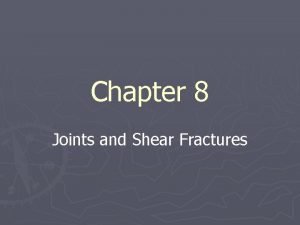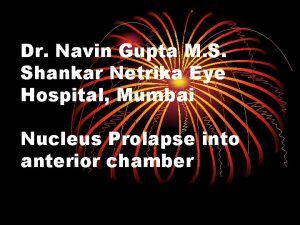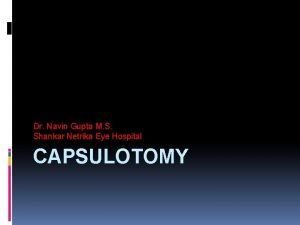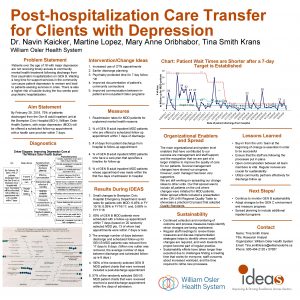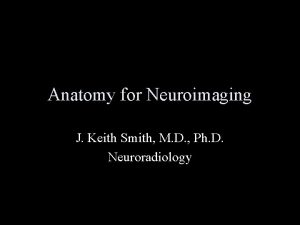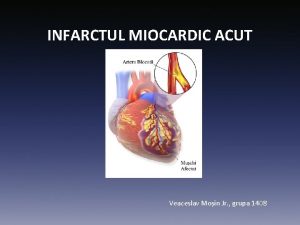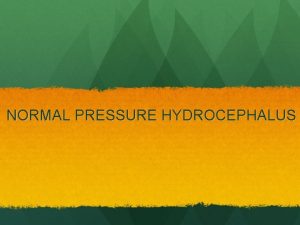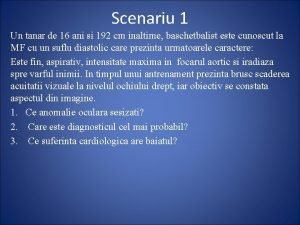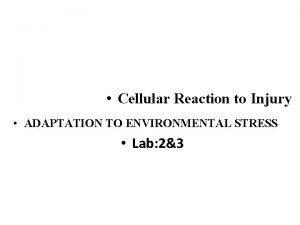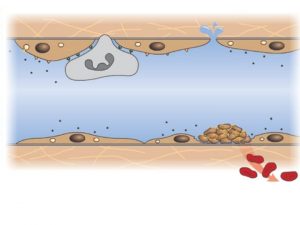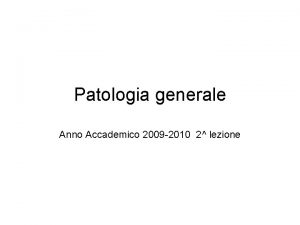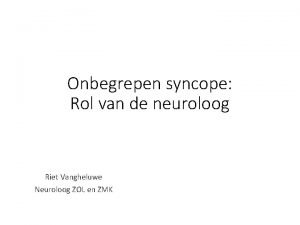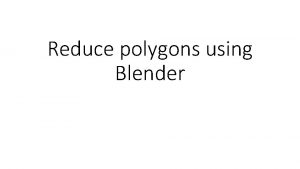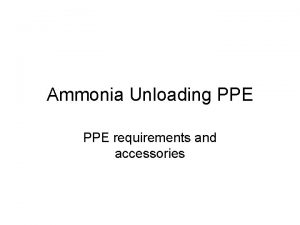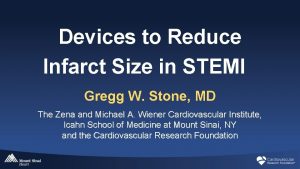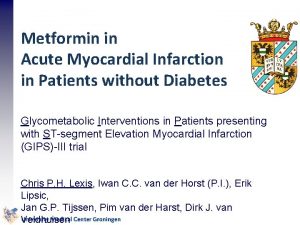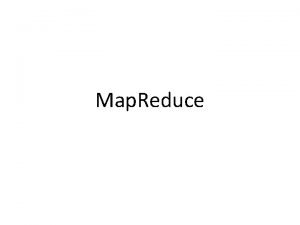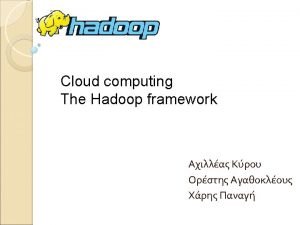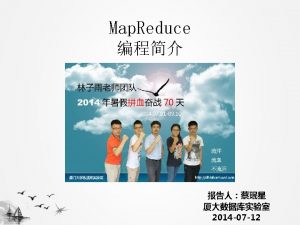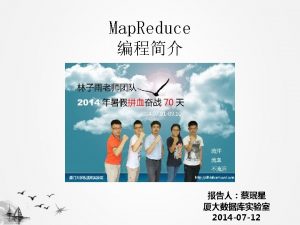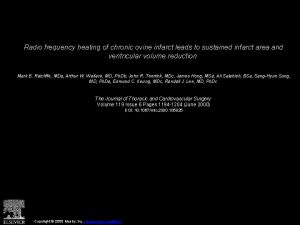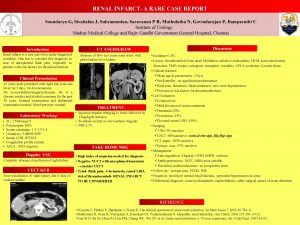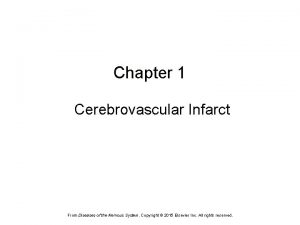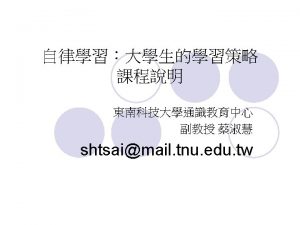LV Unloading to Reduce Infarct Size Navin K






















- Slides: 22

LV Unloading to Reduce Infarct Size Navin K. Kapur, MD, FACC, FSCAI, FAHA Associate Professor, Department of Medicine Interventional Cardiology & Advanced Heart Failure Programs Executive Director, The Cardiovascular Center for Research & Innovation

Disclosure Statement of Financial Interest Research Funding & Speaker/Consulting Honoraria: Abiomed, Abbott, Boston Scientific, Maquet, Medtronic, Liva Nova, MD Start, Cardiac Assist, Neurotronik Equity and Consultant Honoraria: pre. Cardia Herbert J. Levine Foundation Tufts Medical Center RO 1 HL 139785, RO 1 H 133215 Charlton Award Tufts Medical Center

Why do we need the DTU Trial? Size Matters: Larger Infarcts Drive Mortality + HF Median Infarct Size Despite 1 o PCI: 17. 9% of Total LV Mass For every 5% increase in myocardial infarct size 1 -year all-cause mortality increases by 19% & HF hospitalization by 20%. Stone, Selker, Udelson et al. JACC 2016

Acute Load and Poor Outcomes in STEMI LVEDP (>24 mm. Hg) is associated with increased mortality in STEMI Planer and Stone 2011 Am J Card

Why do we need the DTU Trial? Heart Failure after Acute MI Increases Mortality Heart Failure No Heart Failure Desta and Perrson et al SWEDEHEART Study JACC HF 2015

Why do we need the DTU Trial? Heart Failure after Acute MI Decreases Survival Gerber and Roger et al OLMSTEAD COUNTY Circ HF 2016

Mechanical Unloading to Reduce Infarct Size

Door To Unload: STEMI Pilot Trial: Study Design Anterior STEMI Referred for Primary PCI Time is Muscle Electrocardiographic Confirmation Informed Consent and Enrollment Patient preparation, draping, anti-coagulation, anti-platelet therapy, ultrasound guided femoral access, vascular angiogram, left ventriculography, 14 French sheath insertion, then Randomization to U-IR or U-DR ENROLLMENT COMPLETED May 15 2018 Impella CP Insertion + Activation U-IR Group Radial (or femoral access), coronary angiography, coronary wiring and angioplasty U-DR Group 30 minutes of Unloading Radial (or femoral access), coronary angiography, coronary wiring and angioplasty Explant Impella CP after a minimum of 3 hours support Independent Data Safety Monitor, Electrocardiographic, Angiographic, and Cardiac Magnetic Resonance Imaging Core Labs Kapur and O’Neill et al 2019

Impella to PCI Time (mins) A Successful DTU Pilot Trial Established Safety, Feasibility, and Compliance 30 minutes of unloading U-DR 34 mins Average U-IR 11 mins Average Patients Enrolled Zero Bailout PCI in the U-DR Arm Signs of Safety and Potential Acute Efficacy Kapur, O’Neill and DTU Investigators Circulation 2019

Unloading and Delayed Reperfusion Limits Infarct Size Irrespective of the Area At Risk by ST-Sum Kapur et al Circulation 2019

Re-defining Ischemic Time in the Unloading Era Ischemic Time Stops with Unloading Symptom to Unload Time U-DR 176 vs U-IR 200 (Termination of Ischemic Injury) versus Symptom to Balloon Time U-DR 210 vs U-IR 211 (Termination of Ischemic Injury) J Cardiov Transl Res 2019 AHA Late Breaking Presentation 2018

Duration of left ventricular unloading before reperfusion is inversely associated with infarct size in anterior ST-segment Elevation Myocardial Infarction Infarct size / Area-at Risk (%) % IS/AAR (3 -5 day CMR) p<0. 01 65% 49% U-IR U-DR

Trans-valvular Unloading reduces infarct size and preserves mitochondrial structural integrity and cardiolipin content A B Infarct Size / Area at Risk (%) Infarct Size / Total LV Area (%) Area at Risk / Total LV Area (%) Swain and Kapur et al 2019

Uncoupling Ischemic and Reperfusion Injury Experimental Design Swain and Kapur et al 2019

Trans-valvular unloading reduces ischemic injury and reperfusion injury Swain and Kapur et al 2019

Testing Two Anti-Ischemic Strategies to Reduce Infarct Size

Testing Two Anti-Ischemic Strategies to Reduce Infarct Size Steering Committee: Navin Kapur (PI) William O’Neill (PI) Jeffrey Moses Gregg Stone James Udelson Door to Unload vs Door to Balloon

Door to Balloon vs Door to Unload in Anterior STEMI without Cardiogenic Shock Powered for the Primary Endpoint and for the Composite of Secondary Effectiveness Endpoints

STEMI-DTU : Innovation in AMCS Trial Execution

An Interventional Trial to Reduce The Global Burden of Heart Failure


LV Unloading to Reduce Infarct Size Thank you Email: nkapur@tuftsmedicalcenter. org
 Unloading joints
Unloading joints Navin gupta
Navin gupta Health and safety of injection moulding
Health and safety of injection moulding Tectonic joints
Tectonic joints Navin gupta md
Navin gupta md Navin gupta md
Navin gupta md Types of weathering
Types of weathering Navin patney
Navin patney Navin kaicker
Navin kaicker Anatomy of html
Anatomy of html Unda pardee
Unda pardee Adam's triad
Adam's triad Definisme tranpiratie
Definisme tranpiratie Necrotic cells
Necrotic cells Fate of thrombus slideshare
Fate of thrombus slideshare Bipolaire afleidingen ecg
Bipolaire afleidingen ecg Renal infarct
Renal infarct Lacunar infarct meaning
Lacunar infarct meaning Upsloping st
Upsloping st Convulsieve syncope
Convulsieve syncope Blender decrease polygons
Blender decrease polygons Const char * vs char * const
Const char * vs char * const Size separation can be performed by using
Size separation can be performed by using



